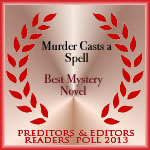 Scenes are the fundamental building blocks of a mystery novel. “Killer” scenes have a clear purpose: to rapidly propel the mystery story forward.
Scenes are the fundamental building blocks of a mystery novel. “Killer” scenes have a clear purpose: to rapidly propel the mystery story forward.
“Killer” scenes in a mystery novel incorporate some kind of change. This change results from the characters repeated effort to overcome an obstacle. Other scenes may be used to introduce characters or to provide backstory that is essential to establish character motivation. Often scenes provide information needed to enable the reader to understand the sequence of events. These are description or exposition scenes.
“Killer” mystery novel scenes have three basic components: a point of view character and her goal, an obstacle to that goal, and a positive, neutral or negative resolution. In addition, scenes may contain dialogue, description, conflict and suspense.
In general, scenes follow a loose pattern. The point of view character appears early in the scene. Usually the scene will take place in only one setting that is described near the opening. In fact, a change of setting often signals a new scene. The length of scenes may vary. Some last for only a couple of paragraphs, others for several pages. A general rule of thumb is description or exposition scenes are shorter while those that focus on suspense and emotion are longer. Each scene should link to a previous one in the story though not necessarily one that immediately precedes.
Begin each “killer” scene with something that raises a question, catches the interest, or shows action. You must hook the reader. Next, introduce the problem the point of view character must overcome. Increase the drama by making her every attempt fail. When she finally succeeds, she must face an even greater challenge until the final climax when the frustrated, nearly beaten sleuth finally wins. This is what creates a well-connected novel.
Caution: Don’t fill every scene with white-knuckle tension. Throw in some less tense narrative type scenes.
“Killer” scenes are the ones that will keep your readers turning the pages of your mystery novel.
Additional writing tips:
9 Ways to Create Tension in a Mystery Novel
How Do Conflict and Crisis Differ in a Mystery Novel?
How Important is Conflict in a Mystery Story?
Pacing: A Critical Element in the Mystery Novel
Alibis and Motives Can Make or Break a Mystery Novel











These are the scenes that feature suspense-filled moments? The near escape? The unwelcome turn of events? I think I know what you mean. I’m just not sure. I think a mystery needs to keep the tension tight yet let the characters live and breathe. Thank you for all your good tips on how to write a mystery novel. Blessings to you…
LikeLike
By: Carol Ann Hoel on December 27, 2010
at 10:50 pm
Hi Carol Ann-You are absolutely right when you say characters need time to live and breathe. That’s why I added this line to my post. “Caution: Don’t fill every scene with white-knuckle tension. Throw in some less tense narrative type scenes.” Thanks for your keen observation.
LikeLike
By: nancycurteman on December 30, 2010
at 8:37 pm
I killer post Nancy 😉 Great advice as always, I am attempting a re-write of my first chapter and this came in very handy, thank you.
LikeLike
By: Alannah Murphy on December 28, 2010
at 3:55 am
That was MEANT tobe “1 Killer post” not sure why I used the Roman I instead it looks terribly surreal “I killer” not, I am not, I am a very nice girl 😉
LikeLike
By: Alannah Murphy on December 28, 2010
at 3:57 am
Alannah, Very cute comment. Thanks for adding a little ray of humor to my post. 🙂
LikeLike
By: nancycurteman on December 30, 2010
at 8:38 pm
Good stuff, as always, Nancy, but for once I need to disagree with you a little.
Perhaps I misunderstood, but when you say ” ‘Killer’ scenes have a clear purpose: to advance the mystery story.”, it sounds like you are saying that other scenes do not need to advance the plot.
I am of the opinion–albeit not very good at it–that EVERY scene, every sentence in fact, must advance the story, the plot.
So many writers go off into detail land, or into the parking lot of useless narration, and force the reader to look ahead to when the story is starting again.
I’ve seen none of that in your work, but really wanted to make the point.
LikeLike
By: Richard W Scott on December 28, 2010
at 11:02 am
Richard, Great comment. After reading it, I immediately revised my post in an effort to clarify my point that “killer” scenes are those scenes needed to rapidly propel the story forward whereas narrative scenes move at a little slower pace.
LikeLike
By: nancycurteman on December 30, 2010
at 8:42 pm
Wonderful post, NC. I’ve really enjoyed reading Global Mysteries this year.
Here’s to 2011!
LikeLike
By: nrhatch on December 31, 2010
at 7:17 am
I wish you a wonderful 2011 year. I think some really great things are in store for all of us.
LikeLike
By: nancycurteman on December 31, 2010
at 1:44 pm